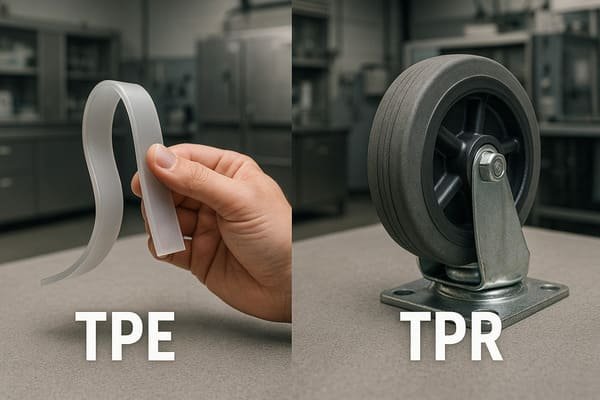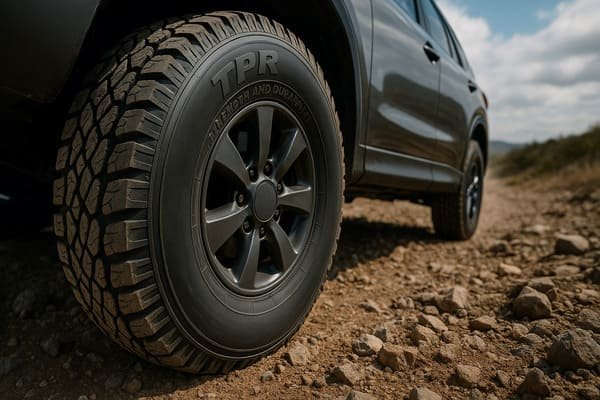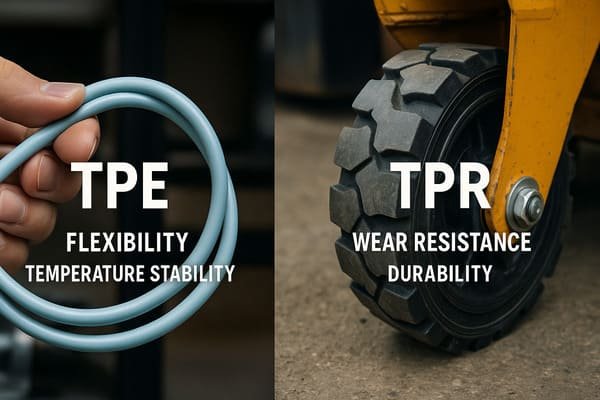Are you trying to decide between TPE (Thermoplastic Elastomer) and TPR (Thermoplastic Rubber) for your application? Understanding the differences in properties, strengths, and uses can help you choose the right material. Let’s compare TPE and TPR to determine which one is better suited for your needs.
TPE and TPR are both versatile materials, but TPE typically offers better flexibility, ease of processing, and temperature stability, while TPR excels in wear resistance and durability.

TPE and TPR are both popular materials in industries that require flexibility and durability. Let’s dive into the unique characteristics of each and explore the factors that make one material more suitable than the other in certain applications.
What Is TPE (Thermoplastic Elastomer)?
TPE is a class of materials that combine the flexibility of elastomers with the processing advantages of thermoplastics. But how does it compare to TPR? Let’s look at TPE's properties and applications.
TPE is a versatile material that combines the best of both rubber and plastic. It is easy to process, flexible, and recyclable, making it ideal for a variety of applications.
Thermoplastic elastomers1 (TPEs) are a group of materials that behave like rubber but can be processed like plastics. They consist of a combination of rubbery and plastic components that are chemically bonded. TPE offers several advantages, including:
- Easy Processing: TPE can be melted and re-molded, which makes it easier to process and recycle compared to traditional rubber materials.
- Flexibility: TPE has excellent flexibility and elasticity, making it ideal for dynamic applications where stretching and recovery are needed.
- Temperature Stability: TPE is known for its ability to withstand a wider range of temperatures compared to many rubber materials, which is essential in various industrial applications.
- Environmental Resistance: TPE is resistant to a variety of environmental factors, including UV light and ozone, which helps extend its service life in outdoor applications.
TPE is commonly used in automotive, consumer goods, medical devices, and packaging, among other industries.
What Are the Disadvantages of TPE?
While TPE offers numerous benefits, it’s not always the perfect material for every application. Let’s explore some of the disadvantages of TPE.
TPE can be more expensive than other materials, and while it offers good flexibility, its wear resistance and chemical resistance may not be as high as other elastomers like TPR.

TPE has some limitations to consider, especially when compared to materials like TPR or natural rubber:
- Higher Cost2: TPE materials are generally more expensive to produce than other elastomers, such as natural rubber or basic thermoplastic materials. This can impact cost-sensitive projects.
- Lower Wear Resistance3: TPE does not have the same wear resistance as TPR, which makes it less suitable for high-stress, high-wear applications.
- Chemical Resistance: While TPE offers some chemical resistance, it generally does not perform as well as TPR or nitrile rubber in environments where exposure to oils, fuels, or harsh chemicals is common.
What Is TPR?
TPR4, or thermoplastic rubber, is a versatile material that combines the best properties of rubber and plastic. Let’s take a closer look at what makes TPR unique and how it compares to TPE.
TPR is a type of rubber that behaves like plastic but has the flexibility of rubber. It can be molded and recycled, offering good strength, durability, and flexibility for various applications.
Thermoplastic rubber (TPR) is a class of materials that exhibit both rubber-like flexibility and plastic-like properties. Unlike traditional rubber, TPR is made from a combination of polymers that can be processed using standard thermoplastic techniques. This means TPR can be melted and re-molded, making it easier to manufacture and recycle compared to other rubber types.
How Strong Is TPR?
How does TPR compare in terms of strength? Let’s break down the properties of TPR and explore its strength in various applications.
TPR is generally stronger than many other elastomers in terms of wear resistance and durability, especially in outdoor and automotive applications, but it may not offer the same level of elasticity as other materials.

TPR is a strong material, particularly in applications that demand durability and wear resistance5. Here’s how TPR compares to natural rubber in terms of strength:
- Wear Resistance: TPR generally offers better wear resistance than natural rubber, especially when exposed to UV light, ozone, and extreme weather conditions. This makes it ideal for outdoor applications, automotive seals, and gaskets.
- Impact Resistance: TPR has good impact resistance, making it suitable for products that are subjected to shocks or heavy impacts, like automotive parts and footwear.
- Strength Under Load: While TPR is strong under static loads, it does not have the same tensile strength as natural rubber in applications that require stretching and flexibility.
- Durability: TPR has a higher resistance to environmental degradation, which makes it a better choice for applications that require prolonged exposure to sunlight, oils, or chemicals.
What Are the Disadvantages of TPR Material?
While TPR offers many benefits, it has certain disadvantages that should be considered when deciding whether it's the right material for your needs.
TPR can be more expensive to produce than other materials, and while it offers good durability, it may not provide the same level of elasticity or chemical resistance as other elastomers.
While TPR offers many benefits, it also has its disadvantages:
- Cost6: TPR is typically more expensive to produce than natural rubber due to the complex processing methods required for its production. This cost can be prohibitive for high-volume manufacturing.
- Elasticity7: While TPR is flexible, it does not offer the same level of elasticity as natural rubber. This means it may not be ideal for applications that require extreme stretching or recovery, such as in tires or certain seals.
- Tensile Strength: TPR generally has lower tensile strength compared to natural rubber. This limits its use in applications where high tensile strength is required, such as in heavy-duty industrial applications.
- Heat Resistance: TPR tends to degrade at lower temperatures compared to some types of natural rubber, which limits its use in high-temperature environments.
| Disadvantage | Description | Impact on Application |
|---|---|---|
| Higher Cost | TPR is generally more expensive to produce than other thermoplastic materials. | Increases manufacturing costs, especially in high-volume production. |
| Lower Elasticity | TPR is not as elastic as other elastomers, limiting its use in applications that require extensive stretching. | Not ideal for applications requiring extreme stretchability. |
| Lower Heat Resistance | TPR has a lower temperature resistance compared to some rubber materials. | Limited for applications exposed to high temperatures. |
| Chemical Sensitivity | TPR may not perform well in environments with oils, fuels, or certain chemicals. | Not suitable for oil or chemical-resistant applications without special formulations. |
| Wear Resistance | TPR generally exhibits lower wear resistance compared to some rubbers like Nitrile or polyurethane. | Not ideal for heavy-duty applications subjected to high wear and tear. |
What Is the Difference Between TPE and TPR?
You may be wondering how TPE and TPR differ in terms of properties and uses. Let’s break down the key differences between these two materials.
TPE and TPR differ mainly in their chemical composition and application suitability. TPE offers better flexibility and temperature stability, while TPR is known for its higher wear resistance and better durability.

The main differences between TPE and TPR stem from their chemical composition and performance characteristics:
-
- TPE: Offers superior flexibility and elasticity, making it suitable for applications that require extensive stretching and recovery, such as seals, gaskets, and medical devices.
- TPR: While TPR also offers good flexibility, it is often more rigid and durable in mechanical applications where wear resistance is more critical.
-
Wear Resistance:
- TPE: TPE’s wear resistance is typically lower compared to TPR, which makes it less ideal for heavy-duty or high-stress applications.
- TPR: TPR excels in wear resistance and durability, making it better suited for automotive parts, footwear, and other high-performance applications.
-
- TPE: TPE generally offers a wider temperature range, allowing it to withstand both low and high-temperature extremes, which is important in many automotive and industrial applications.
- TPR: TPR is somewhat limited in temperature stability, and may not perform as well as TPE in extreme heat or cold.
-
Processing and Recycling:
- TPE: TPE can be easily molded and re-molded, and it is more readily recyclable due to its thermoplastic nature.
- TPR: TPR can also be molded and processed with ease but is more commonly used in applications requiring more durability.
Comparison Table: TPE vs TPR
| Property | TPE (Thermoplastic Elastomer) | TPR (Thermoplastic Rubber) |
|---|---|---|
| Composition | Combines rubber and plastic components in a single material. | Similar to TPE but usually contains a higher concentration of rubber for enhanced flexibility. |
| Elasticity | Highly elastic and flexible, ideal for dynamic applications. | Less elastic than TPE, but still offers good flexibility. |
| Temperature Resistance | Performs well across a wide range of temperatures. | Limited temperature range compared to TPE. |
| Wear Resistance | Good wear resistance, but not as high as TPR. | Excellent wear resistance, particularly in high-stress applications. |
| Chemical Resistance | Moderate chemical resistance. | Strong resistance to oils, fuels, and chemicals. |
| Processing | Easily moldable, recyclable, and re-molded. Can be processed with conventional plastic molding techniques. | Processed similarly to plastics, offering easy molding and high flexibility. |
| Environmental Resistance | Good resistance to UV, ozone, and environmental factors. | More resistant to environmental factors than TPE, but may degrade under extreme conditions. |
| Common Applications | Medical devices, automotive parts, consumer goods, seals, gaskets. | Footwear, automotive seals, gaskets, weatherstripping, toys. |
| Cost | Generally more expensive than TPR due to its superior properties. | Typically cheaper than TPE, especially in heavy-duty applications. |
Conclusion
When choosing between TPE and TPR, the right material will depend on your specific application needs. TPE offers superior flexibility and temperature stability, while TPR excels in wear resistance and durability. Both materials have unique properties that make them suitable for various industries, so understanding these characteristics will help you make the best choice for your project.
🚀 Need Custom TPE or TPR Solutions for Your Specific Application?
Contact Julong Rubber today or Request a Custom Quote for high-quality TPE and TPR products tailored to your needs!
Or reach out to us directly via WhatsApp:

-
Explore the advantages of Thermoplastic elastomers to understand their unique properties and applications in various industries. ↩
-
Learn about the factors contributing to the higher cost of Thermoplastic elastomers compared to other materials, which is crucial for budgeting in projects. ↩
-
Discover the wear resistance characteristics of Thermoplastic elastomers and how they compare to other materials for informed material selection. ↩
-
Explore the unique properties of TPR and how it compares to natural rubber for various applications. ↩
-
Learn about wear resistance and its significance in material selection for durability and longevity in products exposed to harsh conditions. ↩
-
Understanding the cost differences can help you make informed decisions for manufacturing and budgeting. ↩
-
Exploring elasticity differences is crucial for selecting the right material for specific applications. ↩
-
Understanding the flexibility and elasticity of TPE and TPR can help you choose the right material for your application. ↩
-
Learning about temperature stability can inform your choices in extreme environments, ensuring material performance. ↩








